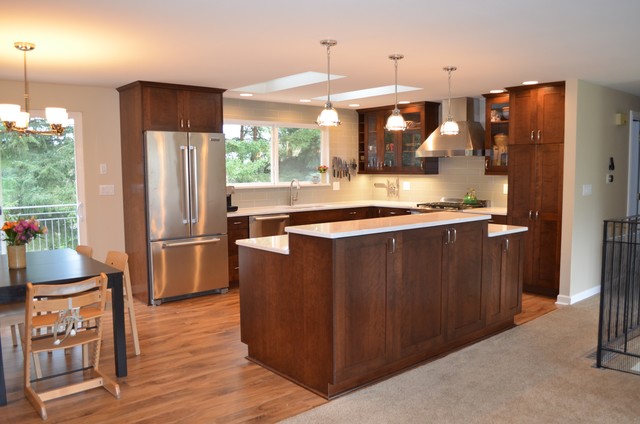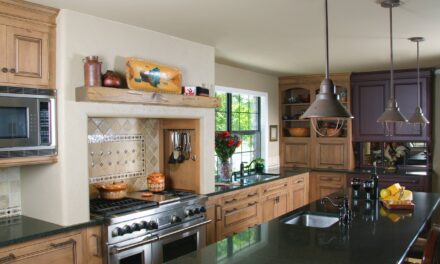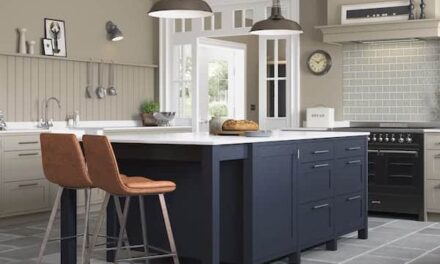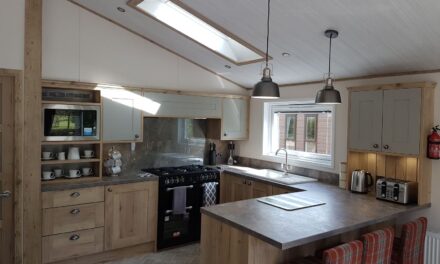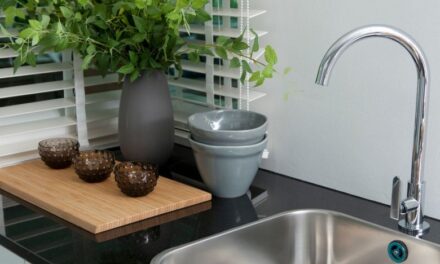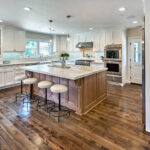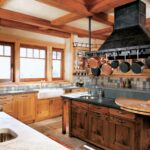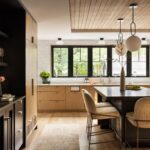split level home kitchen offers a distinctive blend of style and function, combining the charm of multiple levels with a layout designed for both entertaining and everyday living. These kitchens are often situated between the home’s upper and lower levels, creating a natural flow and separation between spaces without sacrificing the open feel that many homeowners crave. The elevated or sunken design allows for creative configurations, such as overlooking a cozy living room or dining area, making it perfect for those who love to host.
One of the standout features of split level home kitchen is their ability to maximize space. With smart use of cabinetry, islands, and tiered countertops, they offer ample storage and preparation areas while keeping everything within easy reach. Large windows and skylights are also commonly used to flood the space with natural light, adding warmth and vibrancy to the heart of the home.
Designing the Perfect Split Level Home Kitchen
Whether designed with a modern, sleek look or a more rustic, cozy aesthetic, a split level home kitchen becomes the centerpiece of the house, blending functionality with charm. Its unique layout makes for a dynamic living space that feels connected while maintaining a sense of distinct areas for cooking, dining, and relaxation. For more information visit here.
Table of Contents
Understanding the Split-Level Kitchen Layout
split level home kitchen typically have multiple levels that are only a few steps apart, often with living spaces on one floor, bedrooms on another, and transitional areas like kitchens or dining rooms on intermediate levels. This design originated in the mid-20th century and remains popular for its efficient use of space, but it can also present challenges when it comes to creating open, connected spaces.
The split level home kitchen-level layout’s segmented nature means that rooms like the kitchen may feel somewhat isolated. However, with careful planning, you can create a kitchen that’s accessible, bright, and connected to the surrounding spaces.
2. Choosing the Right Kitchen Layout
Selecting the right layout is fundamental to making your split level home kitchen efficient and stylish. Here are a few layout styles to consider:
- Galley Kitchen: A galley kitchen, with two parallel countertops, is ideal for narrow split-level spaces. It maximizes storage and prep areas without needing a lot of room. This layout can be ideal if your kitchen area is compact but needs functionality.
- U-Shaped Kitchen: For larger spaces, a U-shaped kitchen provides plenty of storage and countertop space. This layout can also create a cozy, enclosed kitchen that feels distinct from the dining and living areas.
- L-Shaped Kitchen with Island: If your split-level home has an open concept, an L-shaped kitchen with an island can enhance connectivity. The island serves as a social hub, allowing family members and guests to interact with the cook while offering additional storage and seating options.
- Peninsula Layout: Similar to an island but attached on one side, a peninsula can provide added prep space and help define the kitchen area without requiring as much space as a standalone island.
3. Integrating Style and Aesthetics
In a split level home kitchen, the kitchen’s design should complement the architectural style while adding its unique charm. Here are some stylistic considerations:
- Mid-Century Modern: Embracing the style era of split level home kitchen, mid-century modern aesthetics bring sleek lines, natural wood, and minimalist design into your kitchen. Consider wooden cabinets, geometric tiles, and stainless steel accents.
- Contemporary Design: Clean lines, muted color palettes, and modern finishes give a contemporary look to split-level kitchens. Open shelving, polished quartz or granite countertops, and built-in lighting can add to this look.
- Rustic and Farmhouse Styles: For a cozy, inviting kitchen, rustic or farmhouse styles work well. Open shelving, shiplap walls, and vintage-inspired fixtures can create a timeless look that feels both warm and functional.
- Industrial Style: Industrial aesthetics can add an edge to a split-level kitchen, with metal finishes, exposed brick walls, and utilitarian fixtures. It’s a style that fits well in an open-concept split-level home, offering a balance between form and function.
4. Maximizing Space and Storage
Since split level home kitchen are often compact, space and storage optimization is key. Here are some practical tips:
- Utilize Vertical Space: Take advantage of vertical space by installing tall cabinets that reach the ceiling. Adding shelves above counters or in corners can offer more storage without occupying floor space.
- Opt for Multi-Functional Furniture: Kitchen islands that double as storage, prep space, or dining areas can be invaluable in smaller split-level kitchens.
- Pull-Out Cabinets and Organizers: Custom pull-out cabinets, spice racks, and built-in organizers can help you make the most of every inch.
- Choose Compact Appliances: Consider compact or built-in appliances to save counter space. Slim refrigerators, combination microwaves, and dishwashers are excellent choices for limited-space kitchens.
5. Enhancing Lighting for a Bright, Open Feel
Lighting is essential in split level home kitchen, which can sometimes feel boxed in due to the multi-level layout. Here’s how to create a well-lit, welcoming space:
- Layered Lighting: Combining ambient, task, and accent lighting will help brighten the split level home kitchen. Use pendant lights over islands or peninsulas, under-cabinet lights for countertops, and recessed lighting for general illumination.
- Natural Light: If possible, add windows or skylights to bring in natural light, especially if your kitchen is located on a lower level.
- Glass Doors and Open Shelving: Reflective surfaces like glass cabinet doors and glossy tiles can help bounce light around, making the kitchen feel larger and more open.

6. Creating Visual Flow and Cohesion
In a split level home kitchen, creating a cohesive look between the kitchen and adjacent spaces is important. Here are some ways to establish visual flow:
- Consistent Flooring: Using the same flooring across adjacent levels can help unify spaces, making the home feel more cohesive.
- Matching Color Schemes: Choose a color palette that works well with the living and dining areas to ensure a seamless look. Neutral colors, such as whites, grays, and earthy tones, are popular for maintaining harmony.
- Strategic Use of Open Shelving: Open shelving can create a sense of openness and allow you to display items that connect with the decor of nearby rooms, enhancing the home’s aesthetic unity.
7. Incorporating Smart Kitchen Technology
Today’s kitchens often incorporate smart technology to add convenience and functionality. Here are some tech options ideal for split-level kitchens:
- Smart Appliances: Consider smart refrigerators, ovens, and dishwashers that can be controlled via smartphone apps. These appliances can help save time and energy, making kitchen tasks more efficient.
- Voice-Controlled Assistants: Adding a voice-controlled assistant device to the kitchen allows you to set timers, play music, or find recipes without needing hands-on interaction.
- Smart Lighting and Thermostats: Wi-Fi-enabled lighting and thermostats give you more control over the kitchen environment, helping to create a comfortable and energy-efficient space.
8. Balancing Privacy and Openness
Some split level home kitchen have a naturally open concept, while others are more enclosed. Deciding how open or private you want your kitchen to be can influence design choices:
- Partial Walls or Half Walls: If you want some division without full enclosure, partial walls or half walls can provide a compromise. This allows for visual separation while maintaining airflow and connectivity.
- Glass Partitions: Glass partitions provide a modern, semi-open look. They keep the kitchen visually connected to other areas but offer a bit of separation, which can be useful in homes with a lot of kitchen activity.
9. Adding a Personal Touch with Décor
Finally, personalize your split-level kitchen with thoughtful décor and accents. Here are some ideas to make it feel truly yours:
- Artwork and Plants: Small art pieces or potted plants can add warmth and personality to your kitchen. Consider placing these on open shelves or countertops for easy visual impact.
- Textiles and Rugs: Adding a colorful rug or patterned dish towels brings a splash of color and texture, softening the kitchen’s look.
- Decorative Lighting: Unique lighting fixtures like vintage-inspired pendant lights or modern chandeliers can become focal points and conversation starters in your kitchen.
10. Ensuring Safety and Accessibility
In split level home kitchen, ensuring the kitchen is accessible and safe is crucial, especially if it’s situated on a level with stairs nearby.
- Non-Slip Flooring: Choose flooring materials that are non-slip and easy to maintain. This is especially important if the kitchen has direct access to a staircase.
- Adequate Railings and Step Lighting: If stairs are close to the kitchen, consider adding railings and step lighting to enhance safety. Proper lighting around these areas reduces the risk of accidents.
- Accessible Layout: Make sure the kitchen is easy to navigate, with ample space between appliances and counters. This can be particularly beneficial for families with children or elderly members.
Conclusion
Designing a split level home kitchen can be a rewarding experience, combining functionality and style in a unique architectural layout. With thoughtful planning, you can create a kitchen that not only looks great but also serves as a welcoming space for cooking, socializing, and making memories. By choosing the right layout, optimizing space, and adding your personal touch, your split-level kitchen can become the heart of your home—both beautiful and practical.

